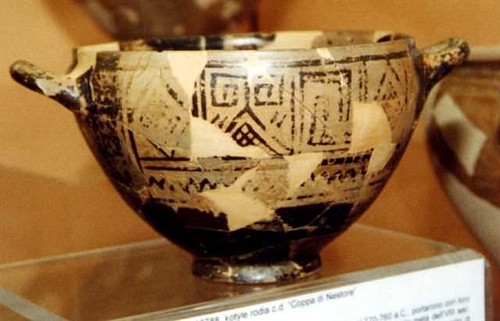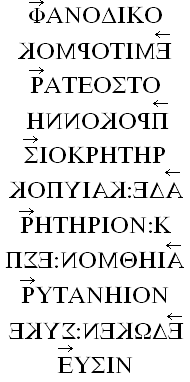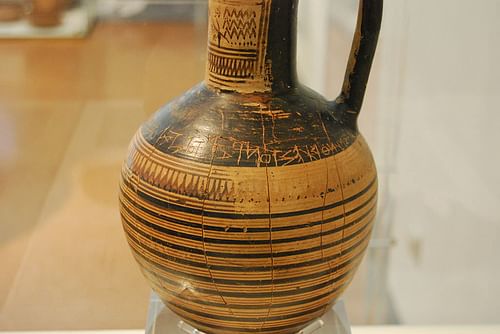In the Greek
The Greek alphabet is the writing system developed in Greece which first appears in the archaeological tape during the eighth century BCE. This was not the offset writing organisation that was used to write Greek: several centuries before the Greek alphabet was invented, the Linear B script was the writing arrangement used to write Greek during Mycenaean times. The Linear B script was lost around c.1100 BCE and with it, all knowledge of writing vanished from Greece until the time when the Greek alphabet was developed.
The Greek alphabet was built-in when the Greeks adjusted the Phoenician writing organisation to represent their ain language by developing a fully phonetic writing system composed of individual signs arranged in a linear fashion that could represent both consonants and vowels. The primeval Greek alphabet inscriptions are graffiti incised on pots and potsherds. The graffiti plant in Lefkandi and Eretria, the 'Dipylon oinochoe' found in Athens, and the inscriptions in the 'Nestor'south loving cup' grade Pithekoussai are all dated to the second half of the eighth century BCE, and they are the oldest known Greek alphabetic inscriptions always recorded.
Origin & evolution of the Greek Alphabet
During the early first millennium BCE, the Phoenicians, who originated in Lebanon, turned into successful maritime merchants, and they gradually spread their influence westwards, establishing outposts throughout the Mediterranean basin. The Phoenician language belonged to the Semitic co-operative of the Afro-Asiatic language family, and it was closely related to Canaanite and Hebrew. With them, the Phoenicians carried goods to trade and also another valuable commodity: their writing system.

Nestor'southward Cup
Even though today the Greek alphabet is simply used for the Greek language, information technology is the root of most of the scripts used today in the western globe.
The Phoenicians had a writing system similar to those used by other Semitic-speaking peoples of the Levant. They did not use ideograms; it was a phonetic writing system equanimous of a fix of letters that represented sounds. Like the mod Arabic and Hebrew writing systems, the Phoenician alphabet only had messages for consonants, not for vowels. The Greeks took the Phoenician alphabet and made a few fundamental changes: they dropped those signs for which in that location was no consonantal equivalent in the Greek linguistic communication and used them instead for individual vowel sounds. As a result, the Greek vowel letters A (alpha), E (epsilon), I (iota), O (omicron), Y (upsilon) and H (eta), came into being equally adaptations of Phoenician letters for consonant sounds that were absent in the Greek language. By using individual symbols to represent vowels and consonants, the Greeks created a writing system that could, for the first time, represent spoken language in an unambiguous mode.
At that place are some considerable advantages that event from these changes. While syllabaries, logographic, and pictographic systems can sometimes exist cryptic to represent voice communication, the Greek alphabet could accurately convey oral communication. In the Nearly Due east and also in the Aegean Bronze Historic period, writing was a skill monopolized by specialists, the scribes. All this would alter in Greece after the fourth dimension of the Greek alphabet: the Greek alphabet had a lower number of signs, making the writing system more accessible for those who wished to larn.
What were the reasons that motivated the Greeks to use such changes to the Phoenician alphabet? This is not fully understood, but it seems likely that certain differences between Phoenician and Greek phonology played a part in the process. While no Phoenician word begins with a vowel (just with a consonant), many Greek words do have a vowel at the starting time. This means that unless the Phoenician alphabet was contradistinct, it would take been incommunicable to write Greek accurately. The fashion these changes were executed is not known with certainty either. However, there are a few inferences that tin can be fabricated based on the archaeological evidence available. It is believed that the innovations were performed past the Greeks in a unmarried move. This is supported by the fact that the classic Greek vowels are all present in the earliest examples of Greek alphabetic writing, with the only exception of Ω (omega). In other words, there is no evidence of a developmental stage of the Greek alphabet as far as we can tell from the earliest recorded examples: if instead of a unmarried motility, the Greeks executed these innovations gradually, we would expect to see examples of defective, inconsistent, or incomplete vowel representations, just none of these has been identified then far. This is ane of the reasons why some believe that the Greek alphabet had a unmarried 'inventor', or at least a specific moment of 'invention'.
In the primeval versions of the alphabet, the Greeks complied with the Phoenician practice of writing from right to left and the letters had a left-facing orientation. This was followed by a menstruation of bidirectional writing, which means that the direction of the writing was in one direction on one line but in the reverse direction on the adjacent, a practice known as boustrophedon. In boustrophedon inscriptions, not-symmetrical letters changed their orientation in accord to the direction of the line that they were part of. During the fifth century BCE, still, the direction of Greek writing was standardized equally left to right, and all the messages adopted a fixed correct-facing orientation.

Ancient Greek Boustrophedon Inscription
Legendary Accounts on the Origin of the Greek Alphabet
The ancient Greeks were more or less aware of the fact that their alphabet was an adaptation of the Phoenician alphabet, and at that place were several accounts well-nigh the creation of the alphabet in ancient Greece. One famous example is reported by Herodotus:
And so these Phoenicians, including the Gephyraians, came with Kadmos and settled this land [Boeotia], and they transmitted much lore to the Hellenes, and in item, taught them the alphabet which, I believe, the Hellenes did not take previously, just which was originally used past all Phoenicians. With the passage of fourth dimension, both the sound and the shape of the letters inverse (Herodotus, 5.58).
The Kadmos mentioned by Herodotus is the Greek spelling for Cadmus, the legendary Phoenician of Greek folklore who was considered the founder and commencement king of Thebes in Boeotia. Interestingly, his name seems to be connected to the Phoenician discussion qadm "east". Because of the supposed interest of Cadmus and the Phoenicians in the manual of the alphabet, in sixth century BCE Crete an official with scribal duties was still called poinikastas "Phoenicianizer" and early on writing was sometimes referred equally "Kadmeian letters". The Greeks called their alphabet phoinikeia grammata, which may be translated every bit "Phoenician letters". Some Greeks, however, were not willing to admit the eastern influence of their alphabet, so they justified the origin of the proper noun phoinikeia grammata with different apocryphal accounts: some said that the alphabet was invented by Phoenix, the tutor of Akhilleus, while others said that the name was linked to the leaves of phoinix "palm-tree".

Dipylon oinochoe inscription
Scripts derived from the Greek alphabet
At that place were several versions of the early Greek alphabet, broadly classifiable into two different groups: the eastern and the western alphabets. In 403 BCE, Athens took the initiative in unifying the many versions of the alphabet, and i of the eastern versions of the Greek alphabet was adopted as the official 1. This official version gradually displaced all other versions in Hellenic republic, and it became dominant. Every bit the Greek influence grew in the Mediterranean world, several communities came into contact with the Greek idea of writing, and some of them adult their own writing systems based on the Greek model. A western version of the Greek alphabet used by Greek colonists in Sicily passed into the Italian peninsula. The Etruscans and the Messapians created their own alphabet based on the Greek alphabet, inspiring the creation of the Sometime Italic scripts, the source the Latin alphabet. In the Near Eastward, the Carians, Lycians, Lydians, Pamphylians, and Phrygians also created their own versions of the alphabet based on the Greek i. When the Greeks gained control of Egypt during the Hellenistic period, the Egyptian writing system was replaced past the Coptic alphabet, which was based on the Greek alphabet too.
The Gothic alphabet, the Glagolitic alphabet, and the modern Cyrillic and Latin alphabet are all ultimately derived from the Greek alphabet. Fifty-fifty though today the Greek alphabet is just employ for the Greek language, information technology is the root script of most of the scripts used today in the western world.
This article has been reviewed for accuracy, reliability and adherence to academic standards prior to publication.
Source: https://www.worldhistory.org/Greek_Alphabet/
0 Response to "In the Greek"
Post a Comment